Last Updated on 19/06/2023
Lübeck is a well-preserved Hanseatic city with an unusual layout. The central position in the Hansa provided him with wealth and prosperity. The feeling of prosperity has faded since then, but has not disappeared: the city now looks well-kept and very visited. It deserves a full day excursion – from nearby beach towns or from Hamburg.
Travemünde – what to do
Luneburg Heath. Schneverdingen
North sea Germany vacation. Things to do
Tourist Attractions Schleswig Holstein map
Cuxhaven. 1. Center
Cuxhaven Döse and Duhnen
Cuxhaven Sahlenburg
Local public transport in Germany
90+ parks and gardens in Germany on the map
How to get to Lubeck
The old town is surrounded by water: the Trave River and a canal. Tourist parking lots are located along the bank of the canal, in the city center there are covered parking lots.
By public transport, it is easy to get there by train or bus: the station is located next to the city gate Holstentor – this is the entrance to the city center.
A little history
The history of Lübeck as a city began in the middle of the 12th century. Before that, Slavic tribes lived here. Heinrich the Lion gave city rights to the city in 1159, and it quickly began to grow and trade with all of Europe, becoming the second largest German city after Cologne. Since 1356, the meetings of the Hansa participants were held in Lübeck. Already in the 13th century, the most important cathedrals of the city were erected, and many houses were built in stone to avoid fires.
The 30-year war did not destroy Lübeck, but the Hansa ceased to exist and trade no longer brought such income. The prosperity of the city was over. At the beginning of the 19th century it was occupied by the French. In the second half of the 19th century, the city became industrialized.
In the II World War the city was bombed. The division of Germany Lübeck suffered badly, the industry gradually declined. However, after the fall of the wall, the city began to develop again.
Lübeck old town
Lübeck is a beautiful city, it has a large historical part – one day can be easily spent just walking around. The entire Lübeck old town is included in the UNESCO list. If you visit museums, it is better to spend two days.
The central street runs through the center of the island, from which the streets descend like ribs to the sides, to the canal and the Trave River. They are called Rippenstrasse (rib-streets). Inside the quarters there are their own internal passages and courtyards (which are considered the most interesting are marked in purple).


We started from the northern end of the Lübeck old town, visited the Hanseatic Museum, reached the Holsten Gate, climbed the Church of St. Peter, visited the church of St. Mary and returned back, thus bypassing less than half of the city – it took 4.5 hours without breaks for eating.
The city strongly reminded Bremen: bricks, parks, villas, roses – only the tourist part is larger and better preserved. Many streets have an ancient look, although there are also modern pieces at the site of destruction after the bombing. Since 1987, the old center has been on the UNESCO list. A picture guide is highly recommended so you don’t miss the most beautiful streets.
Let’s start from the north.
The Burgtor Gate (1), the oldest gate in Lübeck, and the Hubbrücke drawbridge.


Nearby is the Hanseatic Museum (more details below). The museum included the buildings of the former Dominican monastery, which in turn was built in 1227 on the site of the first fortress from which the city began.
Replicas of old ships. View from the terrace at the Hanseatic Museum.

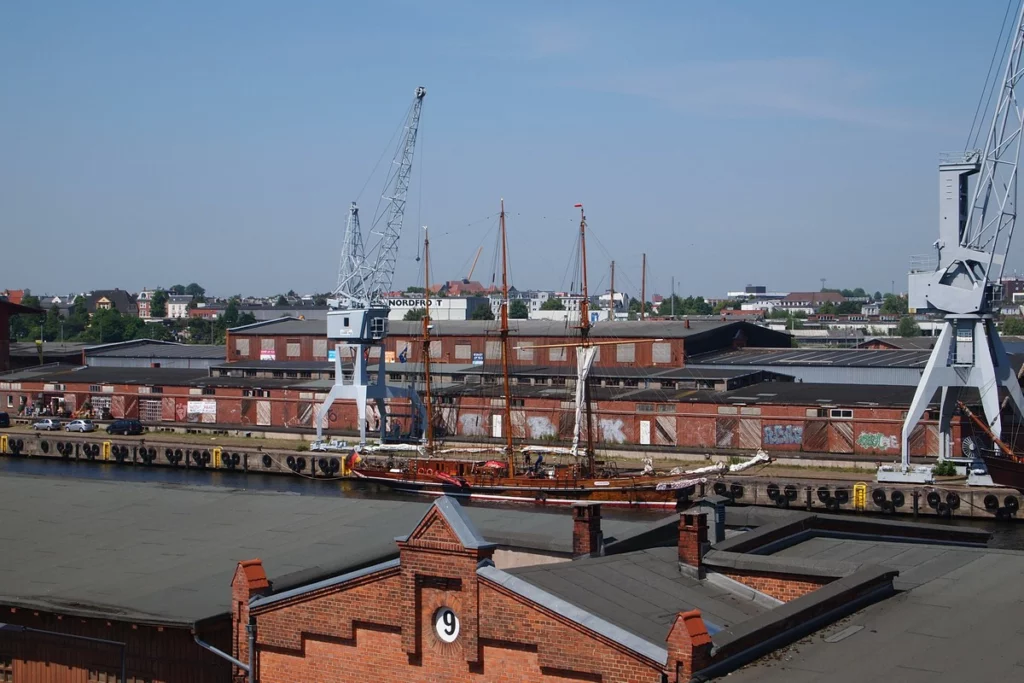
The city became brick after a great fire in the 13th century. Brick was used in different sizes. The Hanseatic Museum tells in detail what devices were used to lift materials and how they strengthened the soil.
Typical street. In this case, Engelsgrube, whose name is associated not with angels, but with the English.


If you guessed to get a map or a guide, then, in addition to such streets, you can find hidden courtyards (Hof) and passages (Gang). For example, those under point 2 on the map.
Behind the front facades are found narrow passages, small picturesque houses entwined with roses. I don’t know how comfortable it is to live there, but such streets look wonderful.
Rich people built them in the 14th century in their backyards to accommodate a growing population and earn from renting out. The poorest segments of the population lived in “booth” with one hearth, benches, without windows and with a toilet in the yard (and there were 80 percent of the Lübeck old town population). In the 16th century, these booths were also ordered to be rebuilt in stone, but the fantasies of the owners to put as many residents as possible in there were not restrained by anything. Except for one thing – the passage should be wide enough to carry the coffin.
From the outside it looks like this.

And inside this

Let’s walk along Trave (3). Ships stop at Hansahafen and then smaller sailing boats at Holstenhafen. You can find a list of the museum harbor ships here. Basically, these are ships of the first third of the 20th century and a couple of the late 19th century.


Lübeck marzipan (4) – café, shop, museum and mid-day show. The known marzipan cafe is also located next to the town hall.

Old hotel. The modern view from the outside belongs to the Renaissance, but the building was originally from the beginning of the 13th century.
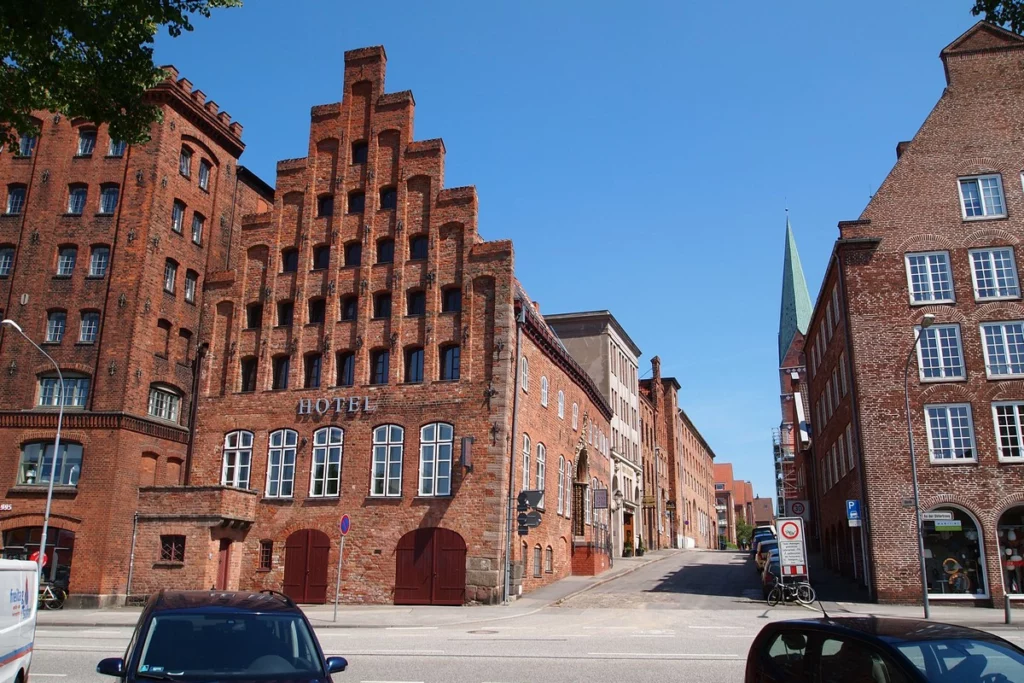
The Holstentor Gate (5) was built in the second half of the 15th century to protect against the Danes. The museum at the gate is dedicated to the city’s history and trade.
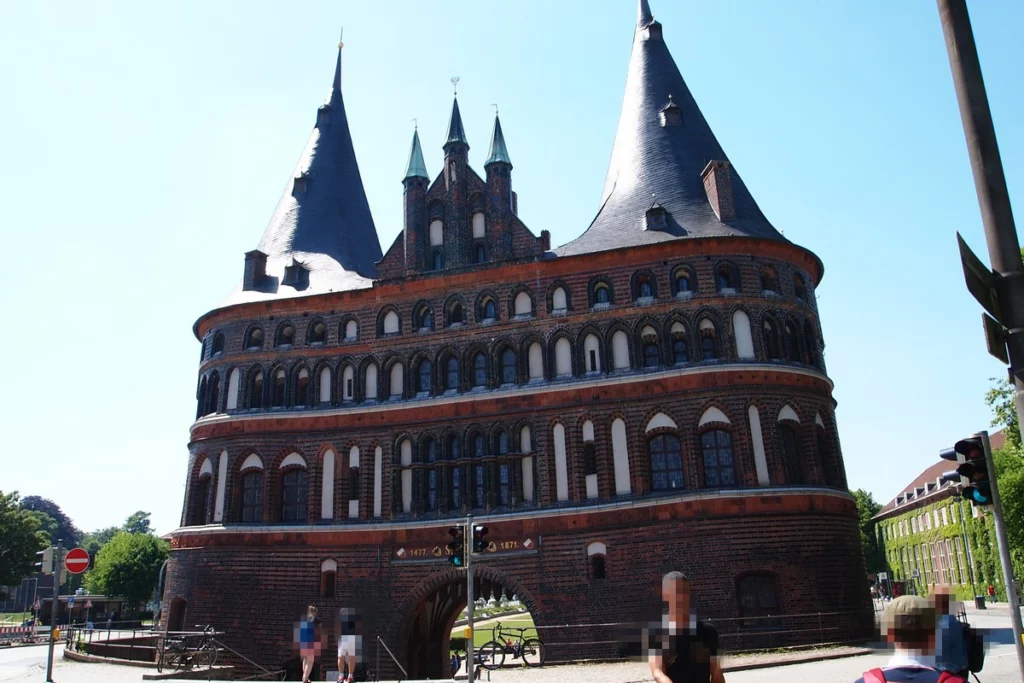

Next to the gate there is an old salt storage (17th-18th centuries, but the facades were rebuilt in the 19th century).

Puppet Museum and small puppet theater (6).
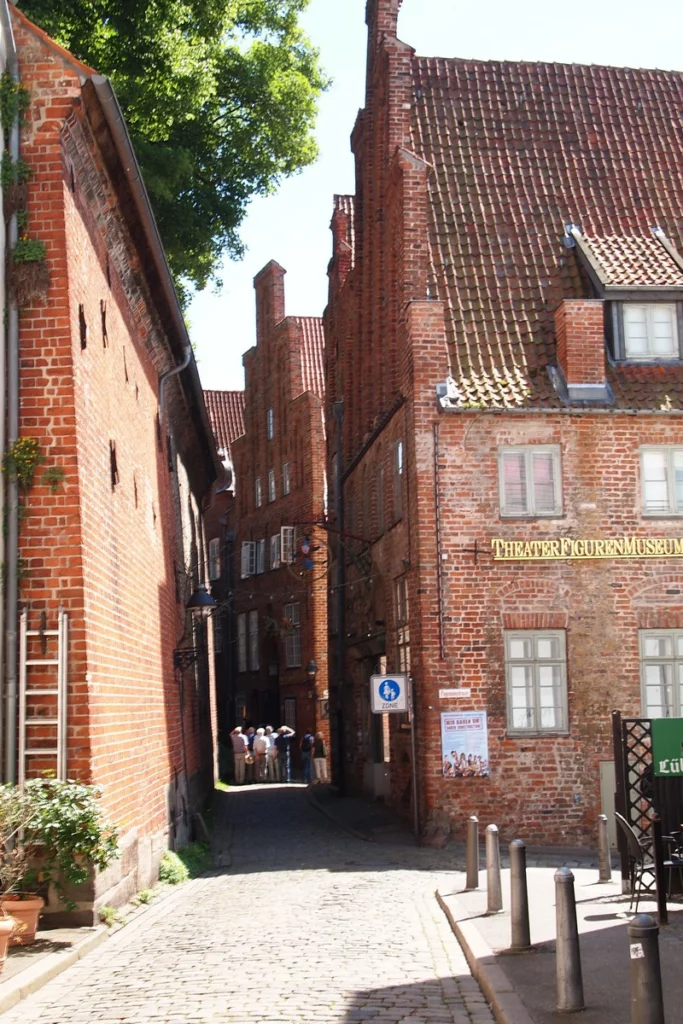

Now let’s take the elevator to the Cathedral of St. Peter (St. Petri, 6). The interiors of the cathedral itself were destroyed, there is nothing interesting there. The cathedral serves for exhibitions and concerts.
From above, you can determine from the facades of houses and roofs where the part that survived the war is, and where the new buildings are.

West view

South-west

South. Cathedral (Dom, 7). The cathedral was restored after the war. The quarters on the right are interesting for their passageways and old houses.

East view. Church of St. Aegidien (10). Around there are the former craft quarters. There are many passages and courtyards built for widows, orphans and the needy. I have marked on the map those that were mentioned as the most interesting. But you can look at others as well.

North side. The center of the old city is the Cathedral of St. Mary and the town hall (11).
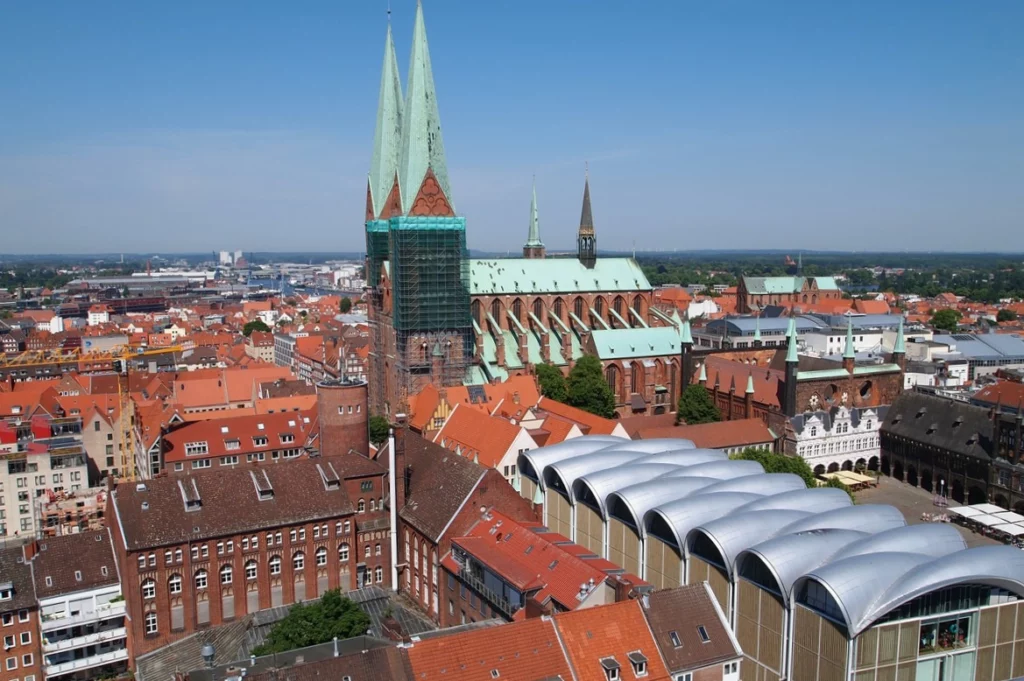

We are going to the town hall. The town hall belongs to the 13th-15th century. Round holes in the walls – for the wind, or rather, against the wind – so that gusts of wind do not fill up the walls.
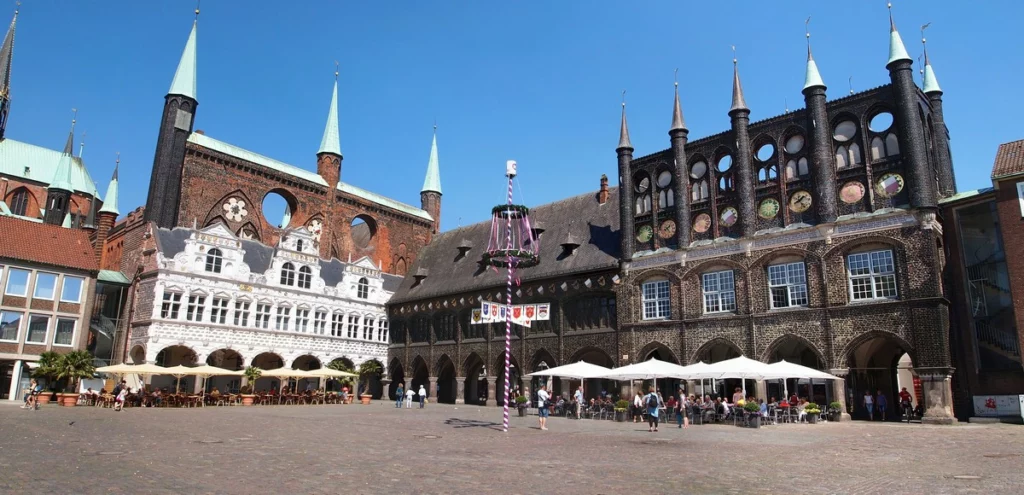


There are guided tours around the town hall several times a day. Duration – 45 minutes.



Some parts, like this staircase from 1594, have been restored, but this does not spoil the feeling in the least.

Church of St. Mary (Marienkirche). The church was built in the 13th-14th centuries, but only the walls remained during the war; most of it has been restored. However, there are also values of the 15th-16th centuries. The entrance fee is a small amount of 2 euros.
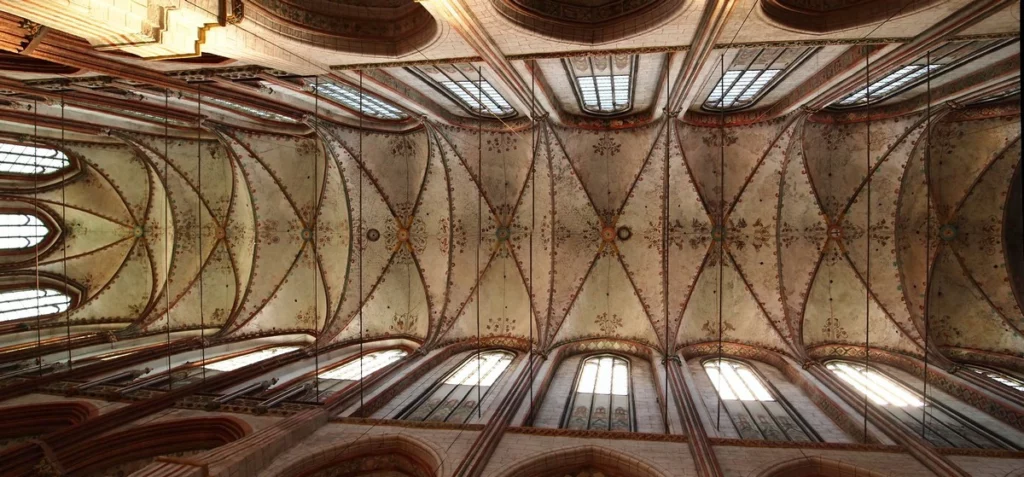


Antwerp Altarpiece 1518


Hospital of St. Spirit (14, Heiligen Geist Hospital) – since 1300, here the sick and the old lived. The inhabitants received a bed, food and from the 17th century as many as 8 warm baths a year. Now part of the buildings around is also a nursing home. At the entrance is a very small church with murals of the 14th-15th centuries.

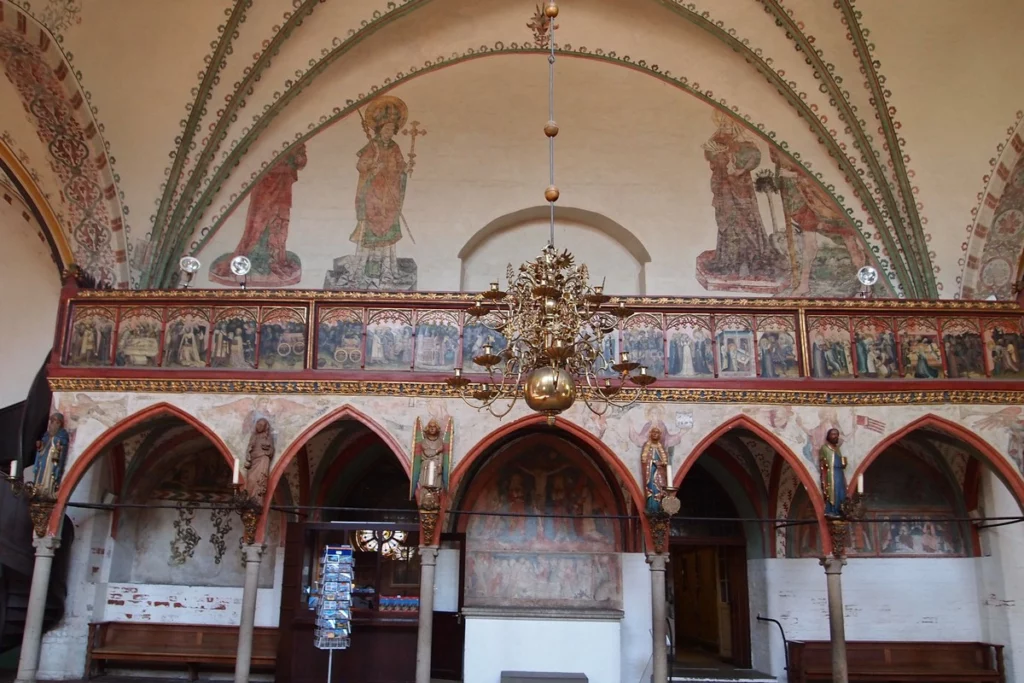



Opposite the church is the old restaurant Schiffergesellschaft. The building is over 500 years old and has always served as a gathering place for sailors. In the interior there are models of ships, a wooden ceiling, benches with coats of arms – depending on where one sailed.
What to visit in Lübeck
Museums offered (from south to north):
St. Annen-Museum (9) – museum of medieval art in the premises of a former monastery: woodcarving, fabrics, Dutch and German paintings, including Cranach the Elder and Memling.
In the backyard of the cathedral there is the Museum für Natur und Umwelt (8), representing the nature of Schleswig-Holstein: fossil skeletons and actual skeletons, plants, birds and their eggs, etc.
The Puppet Museum (6) was closed for renovations. The opening is expected in 2023.
Museum Holstentor (5) – museum in the city gates with an interactive exhibition dedicated to the history of the city and trade
Buddenbrookhaus – museum dedicated to the novel by Thomas Mann. Closed until 2028 for renovations. The temporary exhibition is in the next museum.
Museum Behnhaus Drägerhaus (13) – a complex of two houses of the 18-19th century. In addition to classical and rococo interiors, art from the 19th and 20th centuries is represented, including Caspar David Friedrich and Edvard Munch. The museum is partially closed for renovations.
The museum church Katharinenkirche (12) is the only one that survived the war.
Follow me
Hanseatic Museum (1)
Of the museums, I chose the Hanseatic Museum, because at the box office they said that the exposition is suitable for families with a small child.
Based on the results, I can say that the Hanseatic Museum is already for teenagers. There are not so many exhibits. There is a lot of interactive and multimedia that younger children are completely uninteresting.
At the entrance you need to encode your ticket: enter the desired language, the desired topic. Then just put the ticket on the sign of the ticket – and all the content will be for you in the right language and on the right topic. Content can be in the form of emerging light signatures at archaeological sites, in the form of large information screens with page turning, in the form of wall-to-wall screens with paintings or films.
The translation, which pleasantly surprised me, is professional, without stylistic errors that are so common when translated for tourists. The only thing I didn’t understand was: if I chose everyday life as a topic, but I also want to know about weapons, how can I change it? Or do I need to encode several topics for one ticket at the entrance?
The whole museum is darkened, the pictures are practically not obtained. There is also a sound range, for example, with the sounds of a battle. The halls follow the time:
archeology,
how the Hansa appeared, who it consisted of, what cities it developed,
how Lübeck was built, what and with whom they traded, how they fought and overcame crises.
The information is more designed for teens and adult.
The second part of the museum is the remains of a 13th century Dominican monastery.

Other topics on the #German coast
#Baltic Sea
#North of Germany
Do you enjoy the site without cookies? This means that I work for you at my own expense.
Perhaps you would like to support my work here.
Or change your cookie settings here. I don’t use personalized ads







